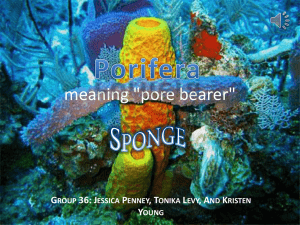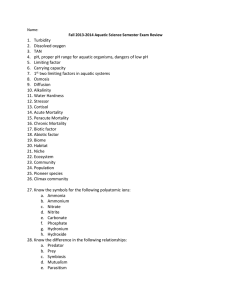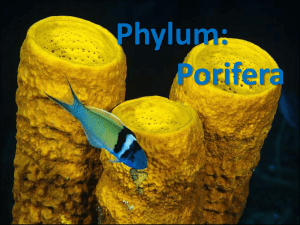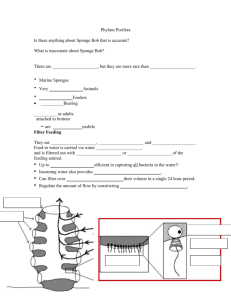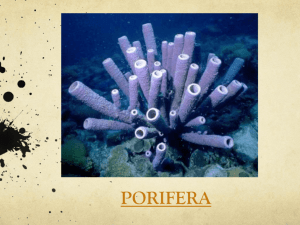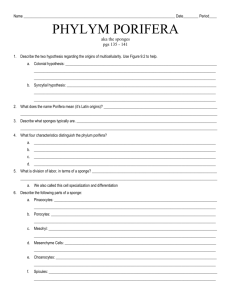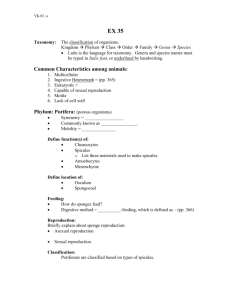Ch12Porifera09
advertisement
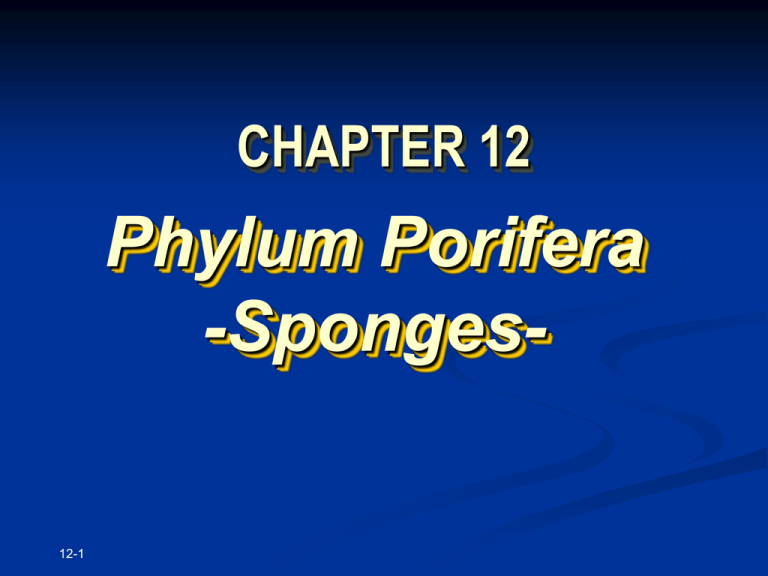
CHAPTER 12 Phylum Porifera -Sponges- 12-1 Copyright © The McGraw-Hill Companies, Inc. Permission required for reproduction or display. A Caribbean demosponge 12-2 Copyright © The McGraw-Hill Companies, Inc. Permission required for reproduction or display. Phylum Porifera Characteristics of Sponges: Multicellular Heterotrophic No cell Walls Few specialized cells (choanocytes) No germ layers (no gastrulation- no gut) Copyright © The McGraw-Hill Companies, Inc. Permission required for reproduction or display. Phylum Porifera General Features Sessile (immobile) sponges are filter feeders Porifera means “pore-bearing” Sac-like bodies with many pores Use flagellated “collar cells”, or choanocytes, to move water to help filter/feed Body is efficient aquatic filter Approximately 15,000 species of sponges Most are marine 12-4 Few live in brackish water, 150 in fresh water Copyright © The McGraw-Hill Companies, Inc. Permission required for reproduction or display. Phylum Porifera Porifera do not have a circulatory, respiratory, excretory system. Porifera Cell Types: (VOCAB) •Choanocytes (also known as "collar cells") - sponge's digestive system. Are used to filter particles out of the water. The beating of the choanocytes’ flagella creates the sponge’s water current. •Porocytes are cells that make up the pores entering into the sponge’s body through the mesohyl (gelatinous non-cellular matrix that holds cells). •Pinacocytes (pinacoderm), the outer epidermal layer of cells. •Myocytes are modified pinacocytes which control the size of the osculum and pore openings and thus the water flow. Copyright © The McGraw-Hill Companies, Inc. Permission required for reproduction or display. Phylum Porifera CELL TYPES CONT Archaeocytes (or amoebocytes) have many functions; They also have a role in nutrient transport and sexual reproduction, they are cells which can transform into: : Sclerocytes secrete calcareous siliceous (silicon/oxygen based) spicules which reside in the mesohyl. Spongocytes secrete spongin; fibers which make up the mesohyl. Collencytes secrete collagen. Spicules are stiffened rods or spikes made of calcium carbonate or silica which are used for structure and defense. Copyright © The McGraw-Hill Companies, Inc. Permission required for reproduction or display. Sessile Sponges - do not move 12-7 Copyright © The McGraw-Hill Companies, Inc. Permission required for reproduction or display. Collar of microvilli surrounding a flagellum. Flagellum beats drawing water containing food through the collar. 12-8 Copyright © The McGraw-Hill Companies, Inc. Permission required for reproduction or display. Phylum Porifera 12-9 Marine sponges found in all seas at all depths and vary greatly in size Many species are brightly colored because of pigments in dermal cells Embryos are free-swimming, adult sponges always attached Irregular shaped Copyright © The McGraw-Hill Companies, Inc. Permission required for reproduction or display. Phylum Porifera Skeletal structure of a sponge can be fibrous and rigid Rigid skeleton consists of spicules Fibrous portion consists of spongin Sponge Classification is based on the composition and shape the spicules 12-10 Copyright © The McGraw-Hill Companies, Inc. Permission required for reproduction or display. Skeletal Structures of Sponges 12-11 Copyright © The McGraw-Hill Companies, Inc. Permission required for reproduction or display. Phylum Porifera Fossil record of sponges dates back to the early Cambrian (540 mya) Living sponges traditionally assigned to 3 classes: Calcarea, Hexactinellida, and Demospongiae 12-12 Copyright © The McGraw-Hill Companies, Inc. Permission required for reproduction or display. 12-13 Copyright © The McGraw-Hill Companies, Inc. Permission required for reproduction or display. Phylum Porifera Form and Function Body openings consist of small incurrent pores or dermal ostia (In), and the osculum (Out) Incurrent pores: Average diameter of 50 m Inside the body Water is directed past the choanocytes where food particles are collected Choanocytes (flagellated collar cells) line some of the canals 12-14 Keep the current flowing by beating of flagella Trap and phagocytize food particles passing by Copyright © The McGraw-Hill Companies, Inc. Permission required for reproduction or display. Phylum Porifera Types of Canal Systems Asconoids: Flagellated Spongocoels Simplest body form Small and tube-shaped Water enters into a large cavity, the spongocoel Lined with choanocytes Choanocyte flagella pull water through All Calcarea are asconoids 12-15 Copyright © The McGraw-Hill Companies, Inc. Permission required for reproduction or display. 3 Sponge Structures 12-16 Copyright © The McGraw-Hill Companies, Inc. Permission required for reproduction or display. Calcarea Sponge 12-17 Copyright © The McGraw-Hill Companies, Inc. Permission required for reproduction or display. Phylum Porifera Syconoids: 12-18 Flagellated Canals Resemble asconoids but larger with a thicker body wall Wall contains choanocyte-lined radial canals that empty into spongocoel Water enters radial canals through tiny openings Spongocoel is lined with epithelial cells rather than choanocytes Food is digested by choanocytes - in radial canals Flagella draw water through internal pores in the spongocoel and out the osculum Classes Calcarea and Hexactinellida have syconoid species (ex: Sycon) Copyright © The McGraw-Hill Companies, Inc. Permission required for reproduction or display. Copyright © The McGraw-Hill Companies, Inc. Permission required for reproduction or display. Cross Section of Sycon 12-20 Copyright © The McGraw-Hill Companies, Inc. Permission required for reproduction or display. Phylum Porifera Leuconoids: Flagellated Chambers Most complex and are larger with many oscula Clusters of flagellated chambers are filled from incurrent canals, and discharge to excurrent canals Most sponges are leuconoid System increases flagellated surfaces compared to volume More collar cells can meet food demands Large sponges filter 1500 liters of water per day 12-21 Copyright © The McGraw-Hill Companies, Inc. Permission required for reproduction or display. Copyright © The McGraw-Hill Companies, Inc. Permission required for reproduction or display. Orange Desmosponge - leuconoid canal system 12-23 Copyright © The McGraw-Hill Companies, Inc. Permission required for reproduction or display. Phylum Porifera Types of Porifera Cells 12-24 Copyright © The McGraw-Hill Companies, Inc. Permission required for reproduction or display. Food Trapping by Sponge Cells 12-25 Copyright © The McGraw-Hill Companies, Inc. Permission required for reproduction or display. Phylum Porifera Cell Independence: Regeneration Sponges have a great ability to regenerate lost parts and repair injuries 12-26 Regeneration following fragmentation is one means of asexual reproduction Copyright © The McGraw-Hill Companies, Inc. Permission required for reproduction or display. Phylum Porifera Asexual reproduction can occur by bud formation External buds Small individuals that break off after attaining a certain size Internal buds or gemmules Formed by archaeocytes that collect in mesohyl Coated with tough spongin and spicules Survive harsh environmental conditions 12-27 Copyright © The McGraw-Hill Companies, Inc. Permission required for reproduction or display. Gemmule- Internal Bud 12-28 Copyright © The McGraw-Hill Companies, Inc. Permission required for reproduction or display. Phylum Porifera Sexual Reproduction Most are monoecious (have both sexes) Sperm and eggs sometimes arise from choanocytes or archaeocytes 12-29 Copyright © The McGraw-Hill Companies, Inc. Permission required for reproduction or display. Phylum Porifera In some, one sponge releases sperm which enter the pores of another sponge Sponges provide nourishment to zygote until it is released as a ciliated larva Some sponges release both sperm and oocytes into water The free-swimming larva of sponges is a solid parenchymula 12-30 Copyright © The McGraw-Hill Companies, Inc. Permission required for reproduction or display. 12-31 A. Development of Demosponge B. Development of Calcareous syconoid sponge Copyright © The McGraw-Hill Companies, Inc. Permission required for reproduction or display. Phylum Porifera Classification Class Calcarea Class Hexactinellida Class Demospongiae 12-32 Copyright © The McGraw-Hill Companies, Inc. Permission required for reproduction or display. Phylum Porifera Class Calcarea (Calcispongiae) BONY Sponges spicules are made of calcium carbonate Spicules are straight or have three or four rays Most are small with tubular or vase shapes Many are drab in color, but some are bright yellow, green, red, or lavender Example: Sycon are marine shallow-water Asconoid, syconoid and leuconoid body forms found in class 12-33 Copyright © The McGraw-Hill Companies, Inc. Permission required for reproduction or display. Hexactinellida Calcarea Demospongiae 12-34 Copyright © The McGraw-Hill Companies, Inc. Permission required for reproduction or display. Phylum Porifera Class Hexactinellida Glass sponges with six-rayed spicules of silica to form their skeleton Strong Internal skeleton with fused spicules Nearly all are deep-sea forms, cup shaped Syconoid and Leuconoid body plans 12-35 Copyright © The McGraw-Hill Companies, Inc. Permission required for reproduction or display. Hexactinellida Calcarea Demospongiae Copyright © The McGraw-Hill Companies, Inc. Permission required for reproduction or display. Phylum Porifera Class Demospongiae Contains 95% of living sponge species Spicules or skeletal system contains spongin Leuconoid body form All marine except for Spongillidae, the freshwater sponges Freshwater sponges 12-37 Widely distributed in well-oxygenated ponds and springs Flourish in summer and die in late autumn Leave behind gemmules Reproduce sexually, but existing genotypes may also reappear annually from gemmules Copyright © The McGraw-Hill Companies, Inc. Permission required for reproduction or display. Phylum Porifera Marine Demosponges Highly varied in color and shape Bath sponges 12-38 Lacks siliceous spicules Have spongin skeletons Copyright © The McGraw-Hill Companies, Inc. Permission required for reproduction or display. Sponges in Class Demospongiae 12-39 Copyright © The McGraw-Hill Companies, Inc. Permission required for reproduction or display. Phylum Porifera Uses: 12-40 Dolphins attach sponge to nose, then search for food in sand. Serves as a protection. Humans - commercial sponges, washing Medicinal purposes?? Antimicrobial compounds found on sponges

